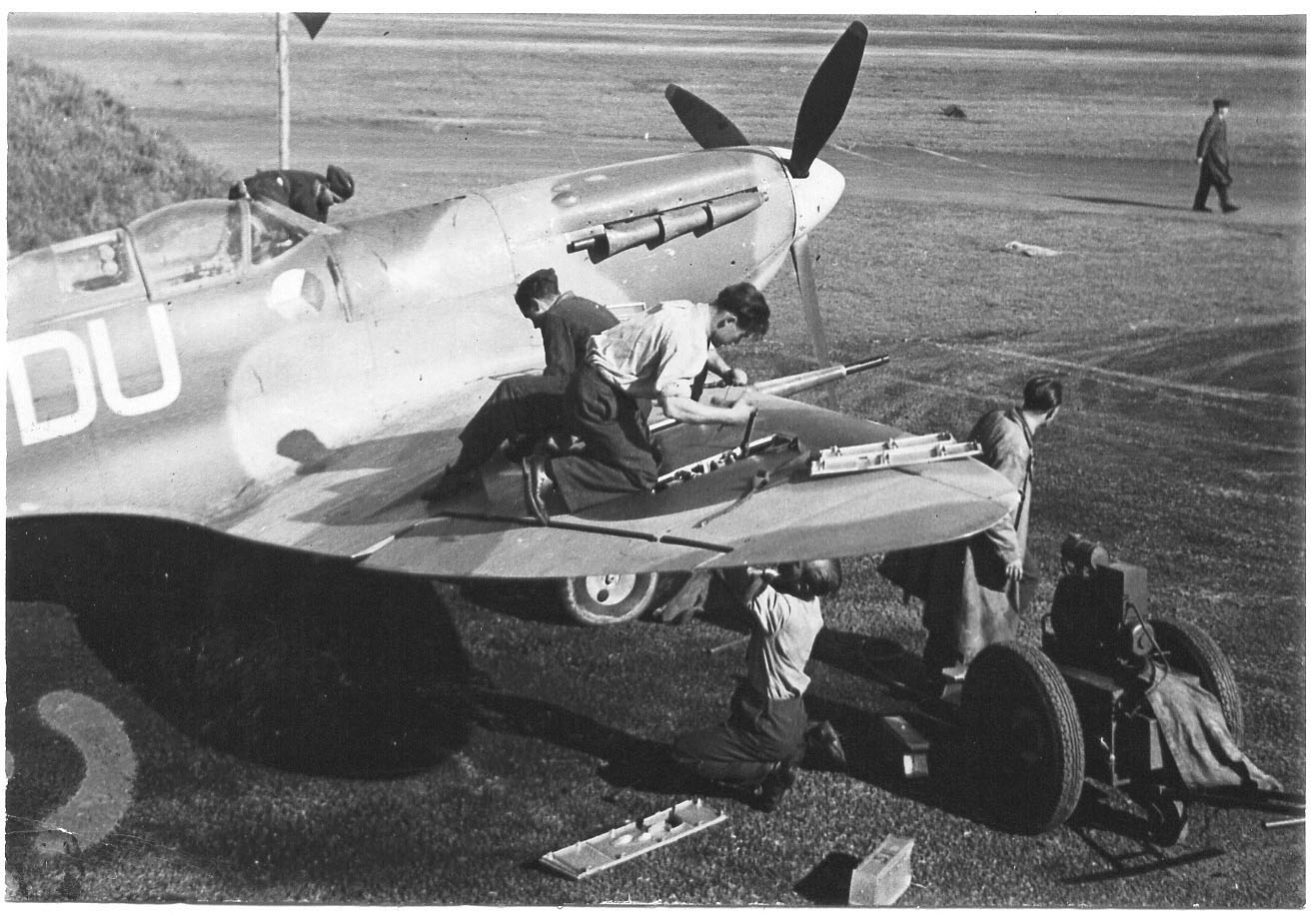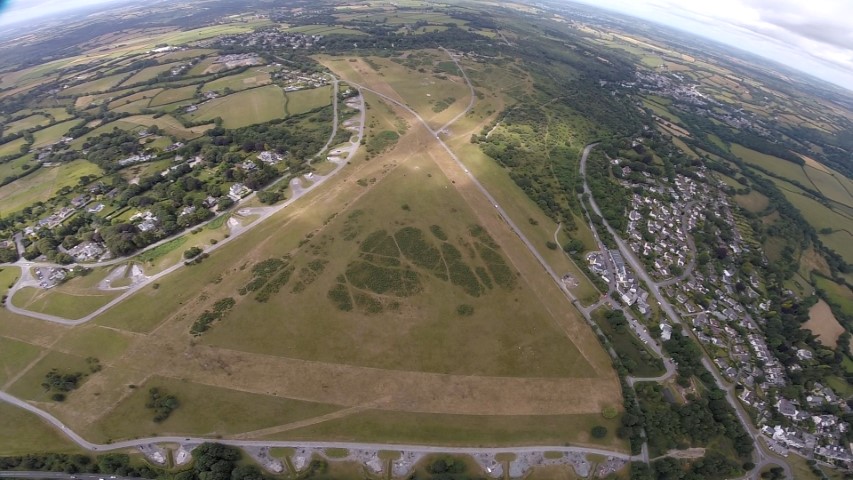
The airfield site during its use. Image: RAF Harrowbeer Interest Group
Located approximately nine miles north-northeast of Plymouth and six miles south of Tavistock, RAF Harrowbeer stands as a reminder of World War II's enduring legacy.
Located within Dartmoor National Park, this former airfield played a significant role in the Allied victory during the Second World War.
Opened on August 15, 1941, RAF Harrowbeer was crucial in the relentless offensive against enemy targets.
It housed various RAF fighter squadrons that contributed to the war effort by mounting numerous sorties.
The Moorlander delved into the history of this remarkable site by reaching out to the RAF Harrowbeer Interest Group.
Stephen Fryer, a key member, shared his passion for the airfield.
Mr Fryer, who joined the group in 2005, has been instrumental in creating their website and delivering talks about Harrowbeer’s history.
The choice of Harrowbeer as an airfield site was not random.
-1721643605086.jpg)
ABOVE: 193 Group at Harrowbeer. Image: RAF Harrowbeer Interest Group
Documents from the 1930s reveal that Plymouth City Council considered three locations: Chelson Meadow, Roborough, and Harrowbeer.
Chelson Meadow was deemed unsuitable due to its hollow terrain, while Roborough’s runway was considered too short.
Harrowbeer, despite its imperfections, was selected due to its relatively favourable land conditions.
The threat of German bombers to Plymouth, initially underestimated, became a harsh reality with the devastating raids of March and April 1941.
This led to an urgent need for Harrowbeer, which was constructed using rubble from the Plymouth blitz and rock from nearby quarries.
The construction of the airfield provided crucial employment for the local community, transforming Yelverton into a hub of wartime activity.
The need for an operational airfield near the city became clear.
Key modifications included reducing local building heights and rerouting roads to accommodate the new airfield.
RAF Harrowbeer became operational in 1941 with the arrival of 500 Squadron, flying Bristol Blenheims.

ABOVE: No 312 Squadron Spitfire being rearmed, Sept 1942. Image: RAF Harrowbeer Interest Group
The airfield saw various units come and go, including Hurricane and Spitfire squadrons, each contributing to the war effort in different capacities.
Harrowbeer, primarily a fighter base, was too small for bomber operations.
In 1942, the airfield expanded to accommodate more units, including Czech and Polish squadrons.
The arrival of Typhoon fighters in December 1942 marked a significant development, with the aircraft playing a crucial role in the Battle of Normandy in 1944.
In February 1943, 263 Squadron arrived with the Whirlwind fighter-bomber, and later, 414 Squadron of the Royal Canadian Air Force operated Mustangs from the airfield.
The Mustangs and other aircraft stationed at Harrowbeer were crucial in air-sea rescue missions and attacks on enemy shipping.
By 1944, Harrowbeer was preparing for Operation Overlord, the Allied invasion of occupied Europe.
After World War II, RAF Harrowbeer’s significance declined.
By 1947, the Air Ministry decided that the airfield was no longer necessary.
A meeting to discuss its de-requisitioning took place in 1950.
The airfield's infrastructure was gradually dismantled, though the runways remained intact for some time.
A proposal to turn Harrowbeer into Plymouth’s airport was met with strong local opposition and was ultimately rejected by the House of Lords in 1961.
The site saw temporary use for local accommodation before being largely demolished. Today, remnants of the runways and hangar bases remain, with some blast pens still visible.
In 1981, a granite memorial was erected near the Leg of Mutton to honour those who served at Harrowbeer.
This memorial, inscribed with "RAF Harrowbeer Operational 1941-1949," serves as a lasting tribute to the airfield’s significance.
The RAF Harrowbeer Interest Group (HIG) work together to preserve the airfield’s history. Founded by a group of individuals, HIG now boasts a number of members who meet regularly to explore and preserve Harrowbeer’s legacy.
-1721643717989.jpg)
ABOVE: The site as it is today
Their efforts include restoring historical sites, creating interpretation boards, and organising events.
One of their major events is the RAF Harrowbeer 1940s Weekend, set for August 17-18. This annual event commemorates the airfield’s history with vintage displays, military vehicles, and family activities.
Highlights include vintage engine displays, historical reenactments, and a variety of trade stalls.
Speaking of the vintage event, Stephen said: “The 1940s Weekend developed out of the Airfield’s 70th Anniversary Commemorations in 2011. It is an opportunity to highlight the role of the Airfield in the defence of the South-West, it’s part in the development of Air Sea Rescue, and to remember the 72 personnel who lost their lives whilst serving at Harrowbeer. We also celebrate the strengths and resilience of the military and general public during the 1940s.”

ABOVE: 2023 1940s Vintage weekend. Image: RAF Harrowbeer Interest Group
For those interested in learning more or contributing to the preservation of Harrowbeer's history, the RAF Harrowbeer Interest Group welcomes new members.
Whether through exploring archival materials, participating in restoration efforts, or simply attending their events, there are many ways to engage with this significant piece of history. For more information or to get involved, visit their website at www.rafharrowbeer.co.uk.
Visitors to the former RAF Harrowbeer site can enjoy a walk around the historic grounds.
The Knightstone Tearooms, now known as the RAF Harrowbeer Archive, Educational and Heritage Centre, offers an opportunity to delve deeper into the airfield's history.
Located in the original Watch Office of RAF Harrowbeer, the centre is accessible and open year-round on Sundays and Wednesdays (except over Christmas).
The tearooms provide a cosy spot for hot and cold beverages, along with pre-packed cakes and biscuits, making it a perfect stop for history enthusiasts and casual visitors alike.
The former airfield has also become a haven for local wildlife.

ABOVE: The airfield today, from above. Image RAF Harrowbeer Interest Group
Today, sheep and Dartmoor ponies roam freely across the site, adding a pastoral charm to the historic landscape.
Ice cream vans are often present, allowing walkers to enjoy a refreshing treat while exploring the area.
This serene setting offers visitors a unique blend of history and nature, inviting them to explore and appreciate the enduring legacy of RAF Harrowbeer.
Subscribe or register today to discover more from DonegalLive.ie
Buy the e-paper of the Donegal Democrat, Donegal People's Press, Donegal Post and Inish Times here for instant access to Donegal's premier news titles.
Keep up with the latest news from Donegal with our daily newsletter featuring the most important stories of the day delivered to your inbox every evening at 5pm.